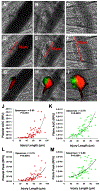Injury measurements improve interpretation of thrombus formation data in the cremaster arteriole laser-induced injury model of thrombosis
- PMID: 33456401
- PMCID: PMC7805486
- DOI: 10.1111/jth.15059
Injury measurements improve interpretation of thrombus formation data in the cremaster arteriole laser-induced injury model of thrombosis
Abstract
Background: The cremaster arteriole laser-induced injury model is a powerful technique with which to investigate the molecular mechanisms that drive thrombus formation. This model is capable of direct visualization and quantification of accumulation of thrombus constituents, including both platelets and fibrin. However, a large degree of variability in platelet accumulation and fibrin formation is observed between thrombi. Strategies to understand this variability will enhance performance and standardization of the model. We determined whether ablation injury size contributes to variation in platelet accumulation and fibrin formation and, if so, whether incorporating ablation injury size into measurements reduces variation.
Methods: Thrombus formation was initiated by laser-induced injury of cremaster arterioles of mice (n=59 injuries). Ablation injuries within the vessel wall were consistently identified and quantified by measuring the length of vessel wall injury observed immediately following laser-induced disruption. Platelet accumulation and fibrin formation as detected by fluorescently-labeled antibodies were captured by digital intra-vital microscopy.
Results: Laser-induced disruption of the vessel wall resulted in ablation injuries of variable length (18-95 μm) enabling interrogation of the relationship between injury severity and thrombus dynamics. Strong positive correlations were observed between vessel injury length and both platelet and fibrin when the data are transformed as area under the curve (Spearman r = 0.80 and 0.76 respectively). Normalization of area under the curve measurements by injury length reduced intraclass coefficients of variation among thrombi and improved hypothesis testing when comparing different data sets.
Conclusions: Measurement of vessel wall injury length provides a reliable and robust marker of injury severity. Injury length can effectively normalize measurements of platelet accumulation and fibrin formation improving data interpretation and standardization.
Keywords: Animal models; Blood Platelets; Fibrin; Thrombosis.
Conflict of interest statement
Conflict of interest RF is a founder and consultant for Platelet Diagnostics. The other authors have no conflicts of interest to disclose.
Figures


Comment in
-
Control of data variations in intravital microscopy thrombosis models.J Thromb Haemost. 2020 Nov;18(11):2823-2825. doi: 10.1111/jth.15062. J Thromb Haemost. 2020. PMID: 33463084 No abstract available.
Similar articles
-
Injury Length and Arteriole Constriction Shape Clot Growth and Blood-Flow Acceleration in a Mouse Model of Thrombosis.Arterioscler Thromb Vasc Biol. 2020 Sep;40(9):2114-2126. doi: 10.1161/ATVBAHA.120.314786. Epub 2020 Jul 9. Arterioscler Thromb Vasc Biol. 2020. PMID: 32640902
-
Par4 is required for platelet thrombus propagation but not fibrin generation in a mouse model of thrombosis.Proc Natl Acad Sci U S A. 2007 Jan 2;104(1):288-92. doi: 10.1073/pnas.0610188104. Epub 2006 Dec 26. Proc Natl Acad Sci U S A. 2007. PMID: 17190826 Free PMC article.
-
Real-time in vivo imaging of platelets, tissue factor and fibrin during arterial thrombus formation in the mouse.Nat Med. 2002 Oct;8(10):1175-81. doi: 10.1038/nm782. Epub 2002 Sep 16. Nat Med. 2002. PMID: 12244306
-
Interactions of platelets, blood-borne tissue factor, and fibrin during arteriolar thrombus formation in vivo.Microcirculation. 2005 Apr-May;12(3):301-11. doi: 10.1080/10739680590925682. Microcirculation. 2005. PMID: 15814438 Review.
-
Thrombus Structural Composition in Cardiovascular Disease.Arterioscler Thromb Vasc Biol. 2021 Sep;41(9):2370-2383. doi: 10.1161/ATVBAHA.120.315754. Epub 2021 Jul 15. Arterioscler Thromb Vasc Biol. 2021. PMID: 34261330 Free PMC article. Review.
Cited by
-
Role of Neutrophils and NETs in Animal Models of Thrombosis.Int J Mol Sci. 2022 Jan 26;23(3):1411. doi: 10.3390/ijms23031411. Int J Mol Sci. 2022. PMID: 35163333 Free PMC article. Review.
-
Scanning laser-induced endothelial injury: a standardized and reproducible thrombosis model for intravital microscopy.Sci Rep. 2022 Mar 10;12(1):3955. doi: 10.1038/s41598-022-07892-z. Sci Rep. 2022. PMID: 35273275 Free PMC article.
-
Switch from oral anticoagulants to parenteral heparin in SARS-CoV-2 hospitalized patients: comment.Intern Emerg Med. 2021 Mar;16(2):517-518. doi: 10.1007/s11739-020-02358-4. Epub 2020 May 6. Intern Emerg Med. 2021. PMID: 32378044 Free PMC article. No abstract available.
-
A humanised thrombus-on-a-chip model utilising tissue-engineered arterial constructs: A method to reduce and replace mice used in thrombosis and haemostasis research.F1000Res. 2025 Jan 20;14:110. doi: 10.12688/f1000research.158910.1. eCollection 2025. F1000Res. 2025. PMID: 40191150 Free PMC article.
-
TMEM16E regulates endothelial cell procoagulant activity and thrombosis.J Clin Invest. 2023 Jun 1;133(11):e163808. doi: 10.1172/JCI163808. J Clin Invest. 2023. PMID: 36951953 Free PMC article.
References
-
- Raskob G, Angchaisuksiri P, Blanco A, Buller H, Gallus A, Hunt B, Hylek E, Kakkar A, Konstantinides S, McCumber M, Ozaki Y, Wendelboe A, Weitz J. Thrombosis: a major contributor to the global disease burden. Journal of Thrombosis and Haemostasis. 2014; 12: 1580–90. - PubMed
-
- Jackson SP. Arterial thrombosis--insidious, unpredictable and deadly. Nat Med. 2011; 17: 1423–36. 10.1038/nm.2515. - PubMed
Publication types
MeSH terms
Substances
Grants and funding
LinkOut - more resources
Full Text Sources
Medical

